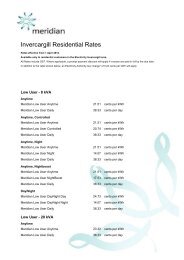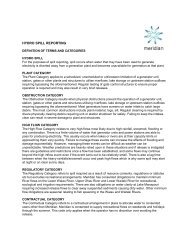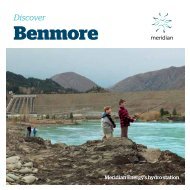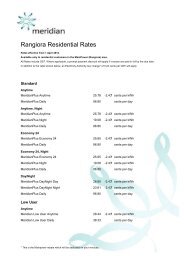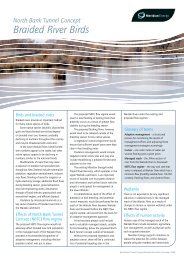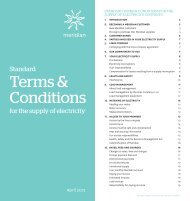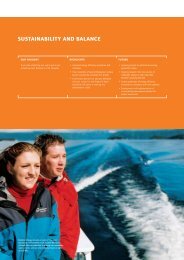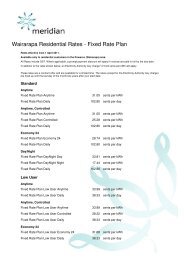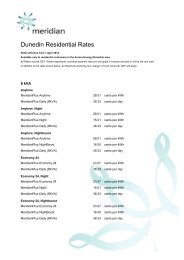Meridian Annual Report - Meridian Energy
Meridian Annual Report - Meridian Energy
Meridian Annual Report - Meridian Energy
You also want an ePaper? Increase the reach of your titles
YUMPU automatically turns print PDFs into web optimized ePapers that Google loves.
44<br />
<strong>Meridian</strong> <strong>Energy</strong> Limited — Notes to the Financial Statements (continued)<br />
Intangible Assets<br />
Customer Acquisition Costs<br />
Customer acquisition costs are finite life intangibles and represent<br />
the capitalisation of costs incurred to acquire retail customers.<br />
Amortisation is calculated using the straight-line method to allocate the<br />
cost over a period not greater than 10 years from the date of acquisition.<br />
Computer Software<br />
Acquired computer software licences, that are not considered an<br />
integral part of related hardware, are capitalised on the basis of<br />
the costs incurred to acquire and bring to use the specific software.<br />
These costs are amortised over their useful lives (three years) on a<br />
straight-line basis.<br />
Costs associated with developing or maintaining computer software<br />
programmes are recognised as an expense as incurred. Costs directly<br />
associated with the production of identifiable and unique software<br />
products that will generate economic benefits beyond one year are<br />
recognised as intangible assets and amortised over their estimated<br />
useful lives (not exceeding three years) on a straight-line basis.<br />
Patents and Trademarks<br />
Patents and Trademarks are finite life intangibles and are recorded<br />
at cost less accumulated amortisation and impairment. Amortisation<br />
is charged on a straight line basis over their estimated useful lives.<br />
The estimated useful lives are between seven and 20 years.<br />
Licence Agreement<br />
The value of a Licence Agreement has been recognised on acquisition<br />
of controlled entities. The Agreement is a finite life intangible and is<br />
recorded at fair value less accumulated amortisation and impairment.<br />
Amortisation is charged on a straight line basis over a period of ten years.<br />
Other licences are also amortised on a straight line basis over their<br />
useful lives (six years).<br />
Research and Development Costs<br />
Expenditure on research activities, undertaken with the prospect<br />
of gaining new scientific or technical knowledge and understanding,<br />
is recognised as an expense as incurred.<br />
An intangible asset arising from <strong>Meridian</strong>’s development activity is<br />
recognised only if all of the following conditions are met: an asset is<br />
created that can be recognised; it is probable that the asset created will<br />
generate future economic benefits; and the cost can be measured reliably.<br />
Development costs that meet these criteria are amortised on a<br />
straight-line basis over their estimated useful lives. Capitalised<br />
development expenditure is stated at cost less accumulated<br />
amortisation and impairment losses.<br />
Development costs incurred that cannot be separately identified<br />
from the physical asset are included in the item of property, plant and<br />
equipment being developed and depreciated over the useful life<br />
of the asset.<br />
If the recognition criteria are not met, development expenditure is<br />
recognised as an expense as incurred.<br />
Impairment of Non-financial Assets other than Goodwill<br />
At each balance date, <strong>Meridian</strong> reviews the carrying amounts of its<br />
tangible and intangible assets to determine whether there is any<br />
indication that those assets have suffered an impairment loss.<br />
Assets that are subject to amortisation/depreciation are reviewed<br />
for impairment whenever events or changes in circumstances indicate<br />
that the carrying amount may not be recoverable. An impairment<br />
loss is recognised immediately in the income statement for the<br />
amount by which the asset’s carrying amount exceeds its recoverable<br />
amount, unless the relevant asset is carried at revalued amount,<br />
in which case the impairment loss is treated as a revaluation decrease.<br />
The recoverable amount is the higher of an asset’s fair value less costs<br />
to sell and value in use. Value in use is the present value of the future<br />
cash flows expected to be derived from the asset. For the purpose of<br />
assessing impairment, assets are grouped at the lowest levels for which<br />
there are separately identifiable cash flows (cash generating units).<br />
In determining the recoverable amount of customer acquisition costs<br />
management has exercised judgement in the following significant<br />
valuation assumptions: sales forecasts, customer numbers, customer<br />
churn, discount rates and forecast of future electricity prices.<br />
In determining the recoverable amount of the license agreement<br />
management has exercised judgement in the following significant<br />
valuation assumptions: sales forecasts (including volumes and pricing)<br />
and discount rates.<br />
Non-financial assets that have suffered impairment are reviewed for<br />
possible reversal of the impairment at each reporting date. A reversal of<br />
an impairment loss is recognised immediately in the income statement,<br />
unless the relevant asset is carried at a revalued amount, in which case<br />
the reversal of the impairment loss is treated as a revaluation increase.<br />
Goodwill<br />
Goodwill, representing the excess of the cost of acquisition over the<br />
fair value of the identifiable assets, liabilities and contingent liabilities<br />
acquired, is recognised as an asset and not amortised, but tested for<br />
impairment annually and whenever there is an indication that the<br />
goodwill may be impaired. Any impairment is recognised in the income<br />
statement and is not subsequently reversed. For the purpose of<br />
assessing impairment goodwill is allocated to cash generating units.<br />
The recoverable amount of goodwill is the net present value of expected<br />
future cash flows of the cash generating units. Key assumptions used in<br />
the valuation model that require management estimation and<br />
judgement include sales forecasts (including volumes and pricing) and<br />
discount rates.<br />
Financial Instruments<br />
Financial assets and financial liabilities are recognised on <strong>Meridian</strong>’s<br />
balance sheet when the Group becomes a party to the contractual<br />
provisions of the instrument (trade date).<br />
Financial Assets<br />
<strong>Meridian</strong> classifies its financial assets as either loans and receivables,<br />
or assets available for sale. The classification depends on the purpose<br />
for which the financial assets were acquired. Management determines<br />
the classification of its financial assets at initial recognition.<br />
Available for Sale Investments<br />
Certain shares held by <strong>Meridian</strong> are classified as being available for sale<br />
and stated at fair value. Gains and losses arising from changes in fair<br />
value are recognised directly in the available-for-sale revaluation<br />
reserve, until the investment is disposed of or is determined to be<br />
impaired, at which time the cumulative gain or loss previously<br />
recognised in the available-for-sale revaluation reserve is included in<br />
the income statement for the period. Dividend income is recognised<br />
separately from other changes in fair value.<br />
Investments in shares that do not have a quoted market price in an<br />
active market and whose fair value cannot be reliably measured are<br />
carried at cost, less any impairment loss to reflect irrecoverable amounts.



